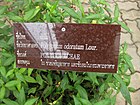Note: This is a project under development. The articles on this wiki are just being initiated and broadly incomplete. You can Help creating new pages.
Difference between revisions of "Persicaria odorata - Vietnamese Coriander"
| Line 1: | Line 1: | ||
| − | |||
| − | |||
[[File:Laksa-bush.jpg|thumb|right|''Persicaria odorata'']] | [[File:Laksa-bush.jpg|thumb|right|''Persicaria odorata'']] | ||
| − | '''Persicaria odorata''' is an herb whose leaves are used in Southeast Asian cooking | + | '''Persicaria odorata''' is an herb whose leaves are used in Southeast Asian cooking. In North-East India, Manipur state uses this as garnishing herb over various cuisines such as Eromba and Singju. Manipuris called it as phak-phai. |
==Uses== | ==Uses== | ||
Revision as of 17:34, 4 July 2018
Persicaria odorata is an herb whose leaves are used in Southeast Asian cooking. In North-East India, Manipur state uses this as garnishing herb over various cuisines such as Eromba and Singju. Manipuris called it as phak-phai.
Contents
- 1 Uses
- 2 Parts Used
- 3 Chemical Composition
- 4 Common names
- 5 Properties
- 6 Habit
- 7 Identification
- 8 List of Ayurvedic medicine in which the herb is used
- 9 Where to get the saplings
- 10 Mode of Propagation
- 11 How to plant/cultivate
- 12 Commonly seen growing in areas
- 13 Photo Gallery
- 14 References
- 15 External Links
Uses
fever, ringworm, vomiting, phagedaena, skin problems, acne, reduce nausea, aid digestion.
Parts Used
Chemical Composition
In the essential oil of Vietnamese coriander, long-chain aldehydes were found, e. g., decanal (28%) and dodecanal (44%), furthermore decanol (11%). Sesquiterpenes (α-humulene, β-caryophyllene) account for about 15% of the essential oil.[1]
Common names
| Language | Common name |
|---|---|
| Kannada | |
| Hindi | |
| Malayalam | |
| Tamil | |
| Telugu | |
| Marathi | NA |
| Gujarathi | NA |
| Punjabi | NA |
| Kashmiri | NA |
| Sanskrit | |
| English | Agrimony |
Properties
Reference: Dravya - Substance, Rasa - Taste, Guna - Qualities, Veerya - Potency, Vipaka - Post-digesion effect, Karma - Pharmacological activity, Prabhava - Therepeutics.
Dravya
Rasa
Guna
Veerya
Vipaka
Karma
Prabhava
Habit
Identification
Leaf
| Kind | Shape | Feature |
|---|---|---|
| Simple | Alternate | Foliar Attachment to Stem is Petiolate and Foliar Shape(s) is Ovate. |
Flower
| Type | Size | Color and composition | Stamen | More information |
|---|---|---|---|---|
| Bisexual | 2-4cm long | Pink, Purple, White | 5-20 | Flower Grouping is Cluster / Inflorescence and Flowering Habit is Polycarpic |
Fruit
| Type | Size | Mass | Appearance | Seeds | More information |
|---|---|---|---|---|---|
| simple | Fruit Type is Indehiscent Dry Fruit (Nut / Nutlet) | Mature Fruit Colour(s) [Angiosperms & Gymnosperms] is Brown | {{{6}}} |
Other features
List of Ayurvedic medicine in which the herb is used
- Vishatinduka Taila as root juice extract
Where to get the saplings
Mode of Propagation
How to plant/cultivate
Succeeds in tropical to warm temperate areas[3]
Commonly seen growing in areas
Terrestrial, Tropical, Sub-Tropical, Monsoonal
Photo Gallery
References
External Links
- Ayurvedic Herbs known to be helpful to treat fever
- Ayurvedic Herbs known to be helpful to treat ringworm
- Ayurvedic Herbs known to be helpful to treat vomiting
- Ayurvedic Herbs known to be helpful to treat phagedaena
- Ayurvedic Herbs known to be helpful to treat skin problems
- Ayurvedic Herbs known to be helpful to treat acne
- Ayurvedic Herbs known to be helpful to treat reduce nausea
- Ayurvedic Herbs known to be helpful to treat aid digestion
- Herbs with Leaves used in medicine
- Herbs with common name in English
- Habit - Perennial
- Index of Plants which can be propagated by Seeds
- Index of Plants which can be propagated by Cuttings
- Herbs that are commonly seen in the region of Terrestrial
- Herbs that are commonly seen in the region of Tropical
- Herbs that are commonly seen in the region of Sub-Tropical
- Herbs that are commonly seen in the region of Monsoonal
- Herbs








